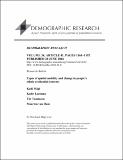Files in this item
Types of spatial mobility and change in people’s ethnic residential contexts
Item metadata
| dc.contributor.author | Mägi, Kadi | |
| dc.contributor.author | Leetmaa, Kadri | |
| dc.contributor.author | Tammaru, Tiit | |
| dc.contributor.author | van Ham, Maarten | |
| dc.date.accessioned | 2016-06-28T15:30:03Z | |
| dc.date.available | 2016-06-28T15:30:03Z | |
| dc.date.issued | 2016-06-28 | |
| dc.identifier | 243708797 | |
| dc.identifier | d0d9bf10-e436-43d2-8917-5943d5459e9a | |
| dc.identifier | 85006957095 | |
| dc.identifier | 000378536700001 | |
| dc.identifier.citation | Mägi , K , Leetmaa , K , Tammaru , T & van Ham , M 2016 , ' Types of spatial mobility and change in people’s ethnic residential contexts ' , Demographic Research , vol. 34 , no. 41 , pp. 1161-1192 . https://doi.org/10.4054/DemRes.2016.34.41 | en |
| dc.identifier.issn | 1435-9871 | |
| dc.identifier.other | RIS: urn:CAFD3F911BE53EBF2E9945BB810CA82D | |
| dc.identifier.other | ORCID: /0000-0002-2106-0702/work/64697570 | |
| dc.identifier.uri | https://hdl.handle.net/10023/9057 | |
| dc.description | This research received funding from the following sources: Institutional Research Grant No. IUT2-17 of the Ministry of Education and Science Estonia; Grant No. 9247 of the Estonian Science Foundation; the European Research Council under the EU FP7 Programme (FP/2007-2013) / ERC Grant Agreement n. 615159 (ERC Consolidator Grant DEPRIVEDHOODS, Socio-spatial inequality, deprived neighbourhoods, and neighbourhood effects), the Marie Curie programme under the EU FP7 Programme (FP/2007-2013) / Career Integration Grant n. PCIG10-GA-2011-303728 (CIG Grant NBHCHOICE, Neighbourhood choice, neighbourhood sorting, and neighbourhood effects). | en |
| dc.description.abstract | Background : Most studies of the ethnic composition of destination neighbourhoods after residential moves do not take into account the types of moves people have made. However, from an individual perspective, different types of moves may result in neighbourhood environments which differ in terms of their ethnic composition from those in which the individuals previously lived. Objective : We investigate how the ethnic residential context changes for individuals as a result of different types of mobility (immobility, intra-urban mobility, suburbanisation, and long-distance migration) for residents of the segregated post-Soviet city of Tallinn. We compare the extent to which Estonian and Russian speakers integrate in residential terms. Methods : Using unique longitudinal Census data (2000-2011) we tracked changes in the individual ethnic residential context of both groups. Results : We found that the moving destinations of Estonian and Russian speakers diverge. When Estonians move, their new neighbourhood generally possesses a lower percentage of Russian speakers compared with when Russian speakers move, as well as compared with their previous neighbourhoods. For Russian speakers, the percentage of other Russian speakers in their residential surroundings decreases only for those who move to the rural suburbs or who move over longer distances to rural villages. Contribution : By applying a novel approach of tracking the changes in the ethnic residential context of individuals for all mobility types, we were able to demonstrate that the two largest ethnolinguistic groups in Estonia tend to behave as ‘parallel populations’ and that residential integration remains slow. | |
| dc.format.extent | 32 | |
| dc.format.extent | 2618040 | |
| dc.language.iso | eng | |
| dc.relation.ispartof | Demographic Research | en |
| dc.subject | Estonia | en |
| dc.subject | Ethnic segregation | en |
| dc.subject | Intra-urban moves | en |
| dc.subject | Migration | en |
| dc.subject | Spatial integration | en |
| dc.subject | Suburbanisation | en |
| dc.subject | GF Human ecology. Anthropogeography | en |
| dc.subject | NDAS | en |
| dc.subject.lcc | GF | en |
| dc.title | Types of spatial mobility and change in people’s ethnic residential contexts | en |
| dc.type | Journal article | en |
| dc.contributor.sponsor | European Research Council | en |
| dc.contributor.institution | University of St Andrews. Geography & Sustainable Development | en |
| dc.identifier.doi | 10.4054/DemRes.2016.34.41 | |
| dc.description.status | Peer reviewed | en |
| dc.identifier.grantnumber | ERC-2013-CoG | en |
This item appears in the following Collection(s)
Items in the St Andrews Research Repository are protected by copyright, with all rights reserved, unless otherwise indicated.

